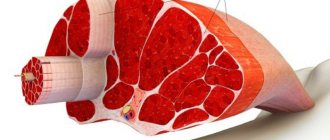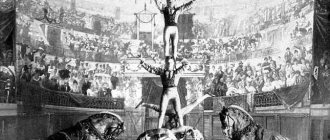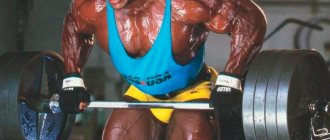The famous American bodybuilder, multiple medalist and winner of prestigious bodybuilding competitions Mike Mentzer (11/15/1951 – 06/10/2001) considered bodybuilding as a serious science that studies the concept of high-intensity training (HIT). In his opinion, in order to achieve greater effectiveness and understanding of the training process itself in bodybuilding, it is necessary to study the medical aspect of the laws of the physiology of stress and its effect on the body when performing high-intensity exercises.
The essence of the “super training” method
The idea of this concept belongs to Arthur Jones, who at one time trained many famous bodybuilders, including Mike Mentzer. Jones argued that to achieve tangible results, an athlete only needs to cut his training in half. Therefore, it was important to determine the minimum required amount of training for each athlete individually.
Arthur Jones's new idea went against the most famous high-volume program of the time, Joe Weider, the founder of the IFBB and the Mr. Olympia competition, as well as a passionate promoter and creator of the infrastructure of this sport, who, to develop the trained muscle, practiced simultaneously increasing the weight of the weight with an increase in the number of repetitions.
More about Joe Weider →
Arthur Jones, in turn, proposed a method of complete failure of the working muscle as a result of a single approach when performing the exercise. Thus, a positive result was achieved by reducing the number of training sessions and training time while increasing the period required for the athlete’s rest.
After his competitive career ended in 1980, Mike Mentzer became involved in coaching. He became a mentor to many bodybuilders, including Dorian Yates, a six-time winner of the Mr. Olympia tournament. Based on the progressive method of Arthur Jones, which Mike himself put into practice since 1971 and over many years of personal observations, he developed his own training system and wrote the book “Super Training”, delving into the philosophy of “heavy, super-powerful stress training”, as well as explaining theoretical foundations and main problems of bodybuilding as a science.
Dorian Yates
Features of Mike Mentzer's training system
- Incompatibility of aerobic and anaerobic exercise. Mentzer believes that there is no need to do cardio training, since it will only slow down muscle development. Working on a treadmill or exercise bike, regardless of before or after training, robs muscles of their potential for growth. Therefore, there is no need to do cardio when training using this method.
- Technique. During training, special attention should be paid to the technique of performing the exercises. All movements are performed smoothly and without jerking, controlling the weight at every point of movement. But there are exceptions, in exercises such as barbell biceps presses and dumbbell swings. They allow a little cheating, but only in the last two repetitions, to achieve failure.
- Weight in exercises. This issue must be approached individually. The weight is selected in such a way that the number of repetitions is not less than 6, but does not exceed 10. If it is less than this range, then the muscle growth mechanism may not start. Well, if it’s more, then you can get oxygen starvation. To avoid such mistakes, it is necessary to follow the following point.
- Training diary. You should not evaluate the results of training only by muscle sensations. This way you can quickly reach the maximum and stop progressing. To avoid this, you must keep a training diary. It will help you remember the results of previous workouts in order to repeat or improve them.
- Stretching and warming up. This is one of the most important parts of training. Since the principle of Mike Mentzer's training system is based on performing one approach, a lot of attention should be paid to the warm-up. In addition to good warm-ups, you need to do stretching. And to warm up your muscles well, you can perform 1-2 warm-up approaches with light weights.
- Pre-fatigue. In an exercise such as the bench press, it is difficult to eliminate the work of the triceps by performing it only with the chest. And since the triceps are much weaker than the chest muscles, they are the first to get tired. To avoid this, we need to resort to pre-fatigue. To do this, we perform dumbbell flyes to tire out the pectoral muscles and then do a full bench press.
Mike Mentzer's training system is a good training option if you hit a plateau and stopped progressing. However, it is not suitable for everyone, since it is designed for intermediate and high-level athletes. Mentzer explains this limitation by the fact that a beginner will not be able to give his best in one approach. Therefore, if you are choosing a program to start training, then circuit training is better for you. Well, if you have stopped progressing and want to try something new, then Mike Mentzer’s training system is just that.
The purpose of "Supertraining"
The goal of the presented training program is to maximize muscle growth through the full realization of your physical potential.
As a result of many years of practice, Mentzer came to the conclusion that an increase in strength and muscle mass occurs as a result of the athlete’s body adapting to intense power load, that is, the trained muscle must work to the so-called “state of failure.” With the correct training scheme, the adaptation effect should occur in the first approach, eliminating the need to maximally load the working muscle by performing a large number of repetitions and approaches. The correct selection of the optimal load is very important here.
Achievements
- 1971 - 2nd place in the Teen Mr America - AAU competition
- 1975 – 3rd place in the Mr. competition. America - IFBB, Medium, 2nd place in the Mr. competition. USA - ABBA, Medium
- 1976 - 1st place in the Mr. competition. America - IFBB, Medium, 2nd place in the Universe competition - IFBB, MiddleWeight
- 1977 - 1st place at the North American Championships - IFBB, MiddleWeight, 2nd place at the Universe competition - IFBB, HeavyWeight
- 1978 - 1st place in the USA vs the World competition - IFBB, HeavyWeight, 1st place in the World Amateur Championships - IFBB, HeavyWeight
- 1979 - 2nd place at the Canada Pro Cup - IFBB, 1st place at the Florida Pro Invitational - IFBB, 3rd place at the Night of Champions - IFBB
- 1979 – 1st place at the Southern Pro Cup competition - IFBB
Supertraining principles
In Mentzer's Supertraining theory, there are key principles such as pre-exhaustion of the loaded muscle, failure of the muscle as completely as possible, and long rest periods between workouts for better recovery.
Pre-fatigue
When performing the main failure set in a basic exercise, not only the main target muscle group receives the load, but also the auxiliary muscles, which Mentzer called the “weak link”. It is important to create a temporary strength advantage for the “weak link”, that is, to prevent its premature failure and enable the target muscle to perform its main task - to fully realize its potential during the working approach. For this purpose, preliminary isolating fatigue of the main muscle is performed while fully maintaining the strength of the additional muscle group.
Repetitions
Mentzer wrote:
“All that is required for growth is one set of exercise, and no more than three sets per muscle group. To “turn on” the growth mechanism, one set to failure is enough.”
This means that after a good warm-up and fatigue of the target muscle group with an isolating exercise, one approach is required until extreme failure. The main difficulty of Mentzer's Supertraining lies in the athlete's ability to exert maximum effort in one last approach, managing to use all the strength potential in it.
Not every athlete can do this task. Its solution largely depends on the correct choice of the repetition system, which, in turn, is compiled taking into account the physical condition, goal, experience and age of the athlete. Individual capabilities determine the type of training to be used in repetitions.
You can combine "positive", "static" and "negative" training, or use exclusively the "positive" repetitions offered to beginners. Experienced bodybuilders can only perform "negative" repetitions.
Mike Mentzer considered “negative” and “static” training to be more energy-intensive, requiring greater physical effort compared to “positive” repetitions. For this reason, in order to avoid overtraining, it was suggested that the first two types of repetitions be performed after a good productive rest.
Long rest
Another main principle of Supertraining is the rest necessary to restore the body between workouts. Muscle growth occurs as a result of stress in the muscular system after HIT and its subsequent adaptation, which occurs as a result of restoration of the body's biochemical resources. It has been noticed that too frequent training does not lead to progress in the growth of muscle mass, but leads to overtraining.
The right combination of training volume with plenty of rest can produce the desired results. Over many years of working with bodybuilders, Mentzer came to the conclusion that each muscle group should be trained no more than once every 10-16 days, depending on the personal characteristics of the athlete. This helps bring the body into the supercompensation phase, that is, increasing the athlete’s physical capabilities and progressing his results in the next workout.
Basic principles of Mike Mentzer's training system
Well, let's get down to the very concept of high-intensity training. The essence of which is based on 3 postulates:
- Strict limitation on the number of approaches in each exercise . Mike Mentzer argued that the number of approaches that athletes perform is excessive and generally unnecessary. By exhausting the muscles with a large number of approaches (3-5), we only slow down the process of their growth. Mentzer considers 1 approach to be the optimal amount. You need to warm up well first.
- The approach must end in failure . This is Mentzer's prerequisite. He believed that work in the first and only set should end with absolute failure, having gone through all its stages, from positive to negative (absolute) failure.
- Long rest period between workouts . This time should be at least 96 hours (4 days) before the next workout. This is exactly how much, in his opinion, a person needs to recover.
All these basics may seem absurd at first glance. But only for the reason that we most likely already have some training experience, which is based on Vader’s high-volume training (abbreviated as HERE). Almost everyone trains using this system. Because of this, high-intensity training seems so unusual.
In the 1st workout, we work the chest and back:
- Bringing your arms together in a machine or raising your arms with dumbbells is performed as a superset with a bench press (1 set of 6-10 repetitions).
- The dumbbell pullover is performed as a superset with a vertical block row (1 set of 6-10 repetitions).
- Deadlift (1 set of 6-10 reps).
After the 1st workout, rest for 3 days, on the 4th workout No. 2.
In the 2nd workout, we work our legs:
- Leg extensions in the simulator are performed as a superset with leg press in the simulator (1 set of 6-10 repetitions).
- Standing calf raise (1 set of 6-10 reps).
After the 2nd workout, rest for 3 days, and on the 4th workout No. 3.
In the 3rd workout, we work on the deltoids and arms:
- Dumbbell lateral raises (1 set of 6-10 reps).
- Bent-over dumbbell raises (1 set of 6-10 repetitions).
- Curling arms with a barbell for biceps (1 set of 6-10 repetitions).
- Extension of the arms on the upper block is performed as a superset with push-ups on the uneven bars (1 set of 6-10 repetitions).
After the 3rd workout, rest for 3 days, and on the 4th workout No. 4.
In the 4th workout, we work the legs:
- Leg extensions in the simulator are performed as a superset with squats with a barbell (1 set of 6-10 repetitions).
- Standing calf raise (1 set of 6-10 reps).
After the 4th workout, rest for 3 days, and on the 4th repetition of the cycle.
Principles of nutrition
Mike Mentzer encouraged his trainees to follow the basic “rules” of bodybuilding: train to failure, avoid overtraining, give the body proper rest to recover, and adhere to the principles of rational nutrition.
He believed that eating right was simple:
- You need to provide yourself with the necessary amount of macro- and microelements and avoid excess nutrients, consuming only as much as the body needs to absorb to complete the task.
- He also advised sticking to a certain ratio of nutrients consumed (15% fat, 25% protein and 60% carbohydrates) and trying not to change this balanced ratio.
- In the combination of training and nutrition, Mentzer considered training to be the main thing, and nutrition as a secondary factor that works only when the right training method is chosen.
"Blue Monster"
Unfortunately, the HIT system has commercial roots. Arthur Jones is not only the founder of his own training system, but also the inventor of the Nautilus simulators. According to the creator's plan, the athlete had to use a complex of four exercise machines, moving from one machine to another. This complex of exercise machines was combined into one huge apparatus, occupying almost the entire gym room. Jones called it "The Blue Monster". In parallel with this, the athlete had to train in the HIT style, and the Nautilus simulators would provide him with the correct (according to Arthur Jones) load along the entire trajectory of movement.
Jones' "Blue Monster" quickly became popular and everyone wanted it. The idea of HIT and simulators was put on a commercial footing, however, few people delved into the very philosophy of high-intensity training.











